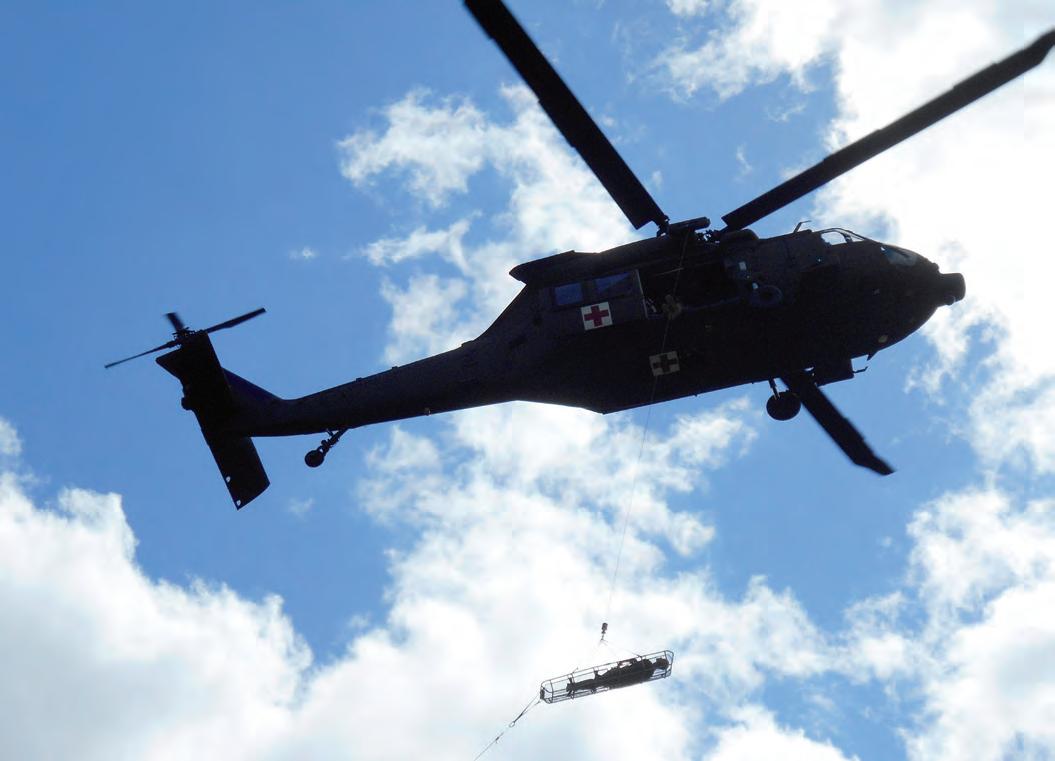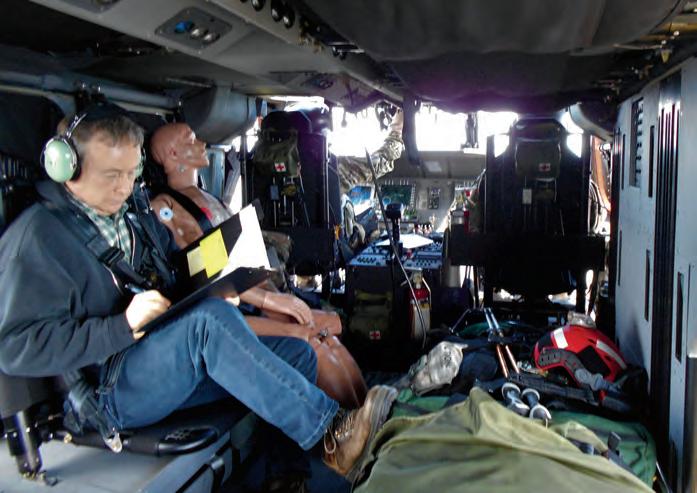
5 minute read
Search and Rescue
Practice is what makes it possible
STORY AND PHOTOS BY MARSHALL HUDSON
I’m in the medical bay of a search and rescue helicopter hovering over Cannon Mountain. The pilot is doing an impressive job holding the Blackhawk in position as gusting winds bounce us around. The cargo doors are wide open and a rescued patient strapped in a litter basket is being hoisted off the ground and pulled in beside me. The patient is pale and unresponsive with a blank look on his face. From personal experience, I know how disconcerting the ride in the swinging basket up into the chopper can be. During the 1990-91 Gulf War, also known as Desert Storm, I succumbed to heat stroke and dehydration, and had my own ride in the litter basket up to a medevac chopper that whisked me off to a hospital. Looking at the patient we just pulled aboard, I am certain he won’t make it to the hospital.
But this is only a training mission, and the “rescued patient” just winched off the ground is a crash-test dummy mannequin. Using a mannequin allows search and rescue personnel to practice loading their patient onto the helicopter without risking life or injury if something were to go wrong. Nothing goes wrong during today’s exercise, and the mannequin voices no objections or complaints about his rescue.
About eight different search and rescue organizations totaling approximately 100 people are here today to practice or observe litter loading from a hovering helicopter cable drop. Many of the people here are volunteers who receive little or no monetary compensation for the hours spent in training or executing a rescue. In addition to volunteering their time, it is not unusual for them to also supply much of their own gear and use of their personal vehicles. In some of the organizations, members must apply and qualify before being accepted as a volunteer. In addition to at least basic first aid knowledge, members must also have the physical fitness, mental toughness, tenacity and endurance traits necessary to carry out a rescue, along with a personality that fits with the rest of the team when all are working under stress.
Also here today are about a dozen K9 search and rescue dogs being trained not to fear the noisy, whirring, hovering, strange machine kicking up gravel at them. Veteran dogs happily hop on board the helicopter ready to be airlifted to a remote area where they will begin their searching efforts. Novice dogs bolt in the opposite direction or lock up all four legs, expressing an “I ain’t going near that thing” attitude.
New Hampshire Fish and Game is the state agency responsible for coordinating and conducting search and rescue missions throughout New Hampshire, and they are assisted by the many professionals and volunteers here today. Fish and Game has their own search and rescue team of specially trained conservation officers who respond to calls all over the state. Fish and Game conducts an average of 140 to 190 search and rescue missions each year looking for lost or injured hikers, climbers, hunters, OHRV operators, and children or elderly persons (Alzheimer’s and dementia patients) who have wandered off into the woods.

The writer takes some notes on a helicopter ride with a quiet partner during a training exercise.
Not all search and rescue calls require a medevac helicopter, but when they do, Fish and Game calls the New Hampshire Army National Guard’s 238th Medevac Company, based in Concord. The 238 Medevac’s Army Guard mission is the expeditious removal of injured personnel from the battlefield, and the resupply of medical equipment and supplies from the rear to the front. To train for their primary mission, they participate in this secondary mission — searching for and rescuing injured hikers in inaccessible terrain such as the White Mountains.
The Blackhawk helicopter we are flying in today is the US Army’s newest and most advanced medical evacuation helicopter. It features a more powerful engine than previous models and has nose-mounted thermal imaging for finding warm bodies in vision-obscured conditions. The medical bay includes an integrated oxygen system for onboard patient care and a litter carrier capable of handling up to six litter patients with seats for two more walking wounded. That maximum capacity might be needed on the battlefield but is unlikely to be needed on a White Mountains search and rescue mission. Looking around, I can’t imagine that much activity in this small area as I’m feeling cramped with just the four-person flight crew and the crash test dummy in a jump seat beside me.
The flight crew consists of a pilot, copilot, flight medic and crew chief. While in search mode, all four work as spotters and each is designated a quadrant outside the chopper to scan. They might also be tasked to reposition Fish and Game personnel, search and rescue teams, or search dogs and handlers to a remote location safer and easier for the rescuer. Picking rescuers up in a parking lot at the bottom of the mountain for a four-minute flight up to the ridgeline might save four hours of hiking just to get into the area where the search begins. But ridgelines don’t always have suitable landing areas, so sometimes the pilot will only be able to touch two wheels to the ground and hover while the search teams jump out.
When in rescue mode, if the pilot is unable to land, the medic might go out the door and ride the cable down to the ground to assist with the rescue and make certain that the patient is properly secured for the litter basket ride up. The crew chief operates the hoist from above, winching both the patient and the medic back on board. Once aboard, the medic will evaluate the patient and determine how fast they need to get to the hospital and whether to go to the nearest hospital or a more suitable trauma care facility that might be farther away. Weather conditions, fading sunlight, approaching storms, other victims and remaining fuel in the tank must be factored into these decisions. The flight crew must work together as a cohesive team, and today’s crew is experienced and on top of their game. The pilot has 30 years of experience and the most junior member has been doing this for five years.
Participating in today’s exercise has taught me that New Hampshire is extremely fortunate to have a skilled combination of Army National Guard, Fish and Game Department personnel, and multiple organizations of dedicated professionals and practiced volunteers working jointly to rescue the lost or injured. I’m impressed with what I saw today, but I’m still planning on not ever needing their services. I make it a point to carry a map, compass, water, extra clothing and other just-in-case essentials when I’m in the woods.
With our mission now complete, we beeline back to the Army National Guard Base in Concord for a debriefing. Today’s training mission was a success even though the rescued patient is still pale and unresponsive with a blank look on his face.

When a rescue requires a medevac helicopter, Fish and Game calls the New Hampshire National Guard.










